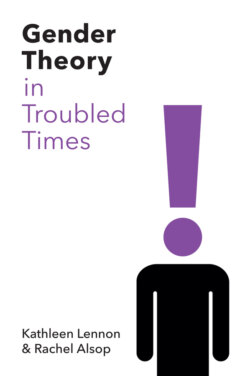Читать книгу Gender Theory in Troubled Times - Rachel Alsop - Страница 22
The sex/gender distinction
ОглавлениеIn the 1980s, the failures which theorists detected in attempts to explain psychological and behavioural sex differences in terms of hardwired biological differences led to the making of one of the most influential distinctions in feminist gender theory – namely, that between sex and gender. For most working with this distinction (for example, Oakley 1985) sex differences – the division into male and female bodies – were seen as biological differences, which it was the domain of the biological sciences to investigate and define. Gender was the term used for the behavioural and psychological traits associated with these different bodies. Gender, here conceived of as masculinity and femininity, something like styles of behaviour and psychological response normatively associated with male and female bodies, was thought of as socially constructed and, consequently, as bearing no necessary relation to biological embodiment. As we have noted above, over recent years the meaning of the term gender has changed. It has shifted from denoting masculinity and femininity, styles of behaviour, to denoting being male or female, categories of sexed difference, without commitment as to whether this difference is biological or social.
The sex/gender distinction became one of the most fundamental assumptions in feminist gender theory from the 1970s on.1 It was fuelled by the recognition of the very different ways in which people with male or female bodies can display masculinity or femininity. Cross-cultural studies showed how norms varied across cultures (Herdt 1994; Mead 1949a, 1949b), as well as the diversity and difference in the norms of gendered behaviour within a culture. For example, the masculinity displayed by a vice-chancellor skilfully eroding democratic constraints on university governance is a very different phenomenon from that shown in a boxing ring. And both of these now overlap with patterns of behaviour displayed by female bodies, for we now have female executives and female boxers. Moreover, as the American anti-slavery and women’s suffrage campaigner Sojourner Truth made clear more than a hundred years ago at the Women’s Convention in Akron, Ohio, the norms of femininity for women vary profoundly with class and colour:
That man over there says that women need to be helped into carriages, and lifted over ditches, and to have the best place everywhere. Nobody ever helps me into carriages, or over mud-puddles, or gives me any best place! And ain’t I a woman? Look at me! Look at my arm! I have ploughed and planted, and gathered into barns, and no man could head me! And ain’t I a woman? I could work as much and eat as much as a man – when I could get it – and bear the lash as well! And ain’t I a woman? I have borne thirteen children, and seen most all sold off to slavery, and when I cried out with my mother’s grief, none but Jesus heard me! And ain’t I a woman? (Truth 1851)
From the earliest feminist campaigns in the West, there has been a recognition of the very different material conditions, and consequent gender norms, experienced by middle- and upper-class women and by the working classes. The higher class women were supposed to display gentility, not to be exposed to physical or mental exertion, to cultivate prettiness in their persons and their houses, and to display high codes of chastity and propriety. Working-class women were required above all to be strong, to carry the burden of work inside and outside the house. They were less constrained by the demands of chastity and propriety (McClintock 1995).
There are, therefore, widely variant norms of gendered behaviour across classes, cultures and geographical locatedness. This variation was seen as indicative of a distinction between sex (thought of as biological) and gender (in the sense of behavioural norms). It also supports the view that, in understanding the construction of gender (in that sense), we are understanding a social process and not a biological one. Masculinity and femininity are categories the content of which is socially variable. Both the scope of the categories (i.e. to whom they apply) and their content (i.e. what is required to be masculine or feminine) are therefore susceptible to modification and change. They are able to float free of attachment to specific bodily form, despite being normatively attached to bodily form in different ways in different socio-historical contexts.
Nonetheless, this highly significant point does not necessarily support the distinction between sex and gender which feminist theorists of the 1980s suggested. The problem with the view is not the part which stresses the way gendered patterns of behaviour are socially mediated but the opposition that it sets up between gender and sex. There is an assumption within these theories that the sexed binary is simply a given, a consequence of biology. Many writers problematize the sex/gender distinction, not because they think gendered behaviours have a biological base, in the way discussed above, but because our understanding of the biological division into male and female is itself culturally influenced (Butler 1990a; Gatens 1996).
